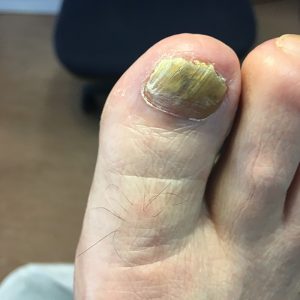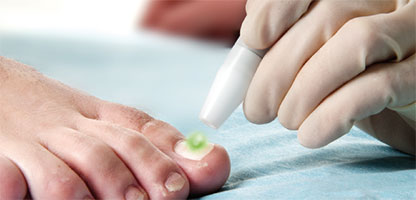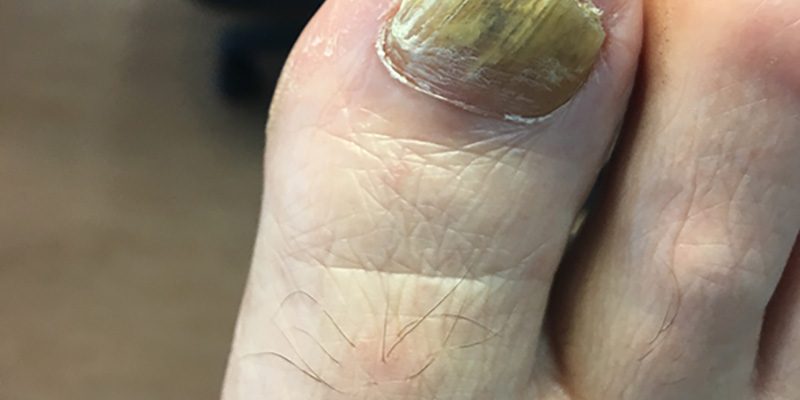About 10% of the adult population has a fungal nail infection. However, as we grow older the incidence of infection rises sharply.
Fungal nail infections, or onychomycosis, can be hard to treat. If you suspect you have a fungal nail infection, it is important to visit a podiatrist early for advice and treatment.
Fungal Nail Infection – Basic Facts
How does a fungal nail infection look like?

There are different types of fungi and, depending on the type of fungus, the infection may appear as white chalky streaks or spots on the surface of the nail. More advanced fungal infections may appear yellow/brownish with a thick chalky build up under the nail. Nails may be “crumbly” when cut.
What causes it?
Fungal organisms called Dermatophytes found on the skin, hair, and nails.
How do you get it?
Fungal infections develop in conditions of warmth, darkness, and moisture.
Repetitive or blunt force trauma to the toe or toenail can weaken the nail structure, making it more susceptible to fungal infection.
In healthy people, fungal infections are often caused by a fungus that is present because the feet are in an excessively moist environment. This includes tight, non-breathable footwear and socks, showers and around swimming pools.
Elderly people or people with underlying health conditions are at higher risk. These conditions include Diabetes, Cancer, Psoriasis. Certain immunosuppressant medications, such as steroids and methotrexate may increase the risk of fungal infection.
How do you prevent fungal nail infection?
- Practice good foot hygiene.
- Frequently wash feet and dry thoroughly, especially in the spaces between the toes.
- Avoid going barefoot in public (ie showers and pool areas).
- Change your socks DAILY, twice a day in warmer weather.
- Do not use other peoples’ footwear.
- Make sure your footwear is breathable.
- Ensure your footwear is the correct size and not too tight.
- Only attend nail salons that adequately sterilize and clean their instruments and bring your own nail polish.
- Treat athletes foot also called tinea pedis ( fungal infection of the skin on the foot ).
- Do not wear the same pair of shoes on consecutive days.
- Wear socks with natural, breathable materials such as cotton, bamboo, and wool.
- Do not wear nail polish for extended periods of time. Ideally, nail polish should be removed after a few days.
Is a fungal infection contagious?
Fungal infections can be contagious and transferred from person to another. The fungus thrives in moist areas so ensure all shower and bathing facilities are cleaned after every use to prevent spreading fungal infections.
How long does it take to treat an infected toe?
The results of treatment will be seen after a nail has grown from base to tip. In adults, this takes 12-18 months and in children 6 to 12 months.
Available toenail fungus treatment
Anti-fungal laundry detergent
Wash your socks in an antifungal wash such as Canestan or Bluo. Always wash your socks separate from your other clothes.
Oral Medication
A range of oral medications is available for fungal infections of the nail. Podiatrists who prescribe medication will advise on the most appropriate medicine to use for nails with a fungal infection.
Topical Medication
There are a variety of topical solutions and creams available to treat fungal nail infections. Treatment with topical medications alone has a limited ability to clear fungal infections of the nail.
Laser Therapy
Laser therapy is now available to treat fungal toenail infections. Fungal nail laser treatment penetrates the nail easily. Heat is generated beneath the nail plate, at the site of infection. This destroys the fungal cells. Generally, the treatment is pain-free and requires no local anesthesia. This is proving to be the most effective treatment for fungal infections of the nail with success rates of up to 70%.
Complications For Untreated Fungal Nail Infections
Like mild skin infections such as acne, fungal nail infections are considered to be minor health-related cases in the society. They naturally disappear with proper medications.
However, fungal nail infections that are not treated properly may worsen and develop complications. Here are some possible complications when treatment is inadequate:
Chronic Pain
Having an infected nail may cause severe pain in the long run.
The nails serve as additional external appendages of our skin. Although not all of its part is attached, the proximal part of the nail is connected directly to our body.
When the nails become infected with fungus and are not treated properly, the infection disrupts the integrity of the whole nail structure.
This may weaken its attachment and make the nail movable. The frequent rubbing between the movable nails and the skin underneath may result in irritation and pain.
Detachment of the whole nail may also occur in severe cases where the infection spreads into the nail matrix.
Spread of Fungal Infection
A simple nail infection, if left untreated, can spread to its surrounding skin. An example of this event is an athlete’s foot.
An athlete’s foot, also known as tinea pedis, may start off as an untreated toenail infection.
With frequent use of socks and shoes, the foot’s environment becomes humid and warm which is the natural niche of fungi. This accelerates the fungi’s growth and spread, and apparently leads into athlete’s foot.
Aside from the foot, the infection likely spreads to the groins (Jock’s Itch), the armpits and all the other parts of the body that sweats a lot.
Invasive Fungal Infection
When a person who is immunocompromised contracts a nail fungal infection, it may result in an emergency situation.
People with diabetes, cancer, HIV and other illnesses that may weaken the immune system should take extra care when having nail fungal infections.
The body normally wards off fungus but if the immune system is down, fungi can readily enter the circulation when an opportunity arises.
When fungi enter the bloodstream, without the natural defense mechanisms, the worst-case scenario would be fungal sepsis.
Fungal sepsis is the term used to describe the deadly reaction of the body in response to a systemic fungal infection.
Frequently Asked Questions
Can fungal infections be treated with antibiotics?
NO! Antibiotics are limited only for treating diseases caused by bacteria.
However, some physicians give both anti-fungal and anti-bacterial agents for treating fungal nail infections to prevent the occurrence of bacterial infection.
Why are there only limited types of medications for fungal infections?
Fungi and humans share the same ancestry which is the domain Eukarya. The domain Eukarya are composed of organisms whose cells have a true nucleus and membrane-bound organelles.
Medical practitioners have difficulty in making new anti-fungal drugs because these drugs usually work by targeting fungal cells and killing them.
Unfortunately, humans and fungi share the same ancestral domain and the difference in cellular compositions does not have much variation. This similarity causes anti-fungal drugs to target both fungal and human cells which may cause harm to our body.
Only the most selective fungus-specific drugs are released in the market and thus the choices become limited.
What is the best treatment for mild fungal nail infection?
There are no established rankings when it comes to treating fungal nail infections. However, most physicians recommend that the best general treatment for mild to moderate fungal infections is the practice of proper hygiene.
The human body, given that the immune system works properly, can fight-off mild fungal infections on its own.
The only thing you need to do is wash the infected area properly.
It would also be in your best interest to make sure that the affected nail is kept away from aggravating factors such as
- Dirt
- Enclosed Humid Spaces
- Dark Areas
- Warm Environments
Early Intervention is Key
With early intervention, you can avoid complications and shorten treatment period. Contact us today for any signs of fungal nail infection.


